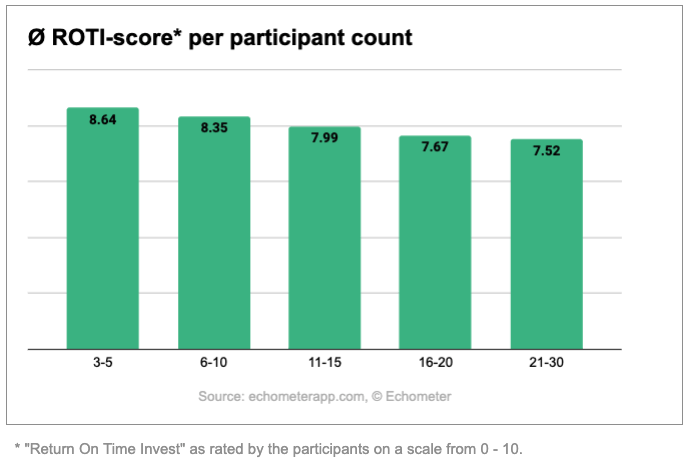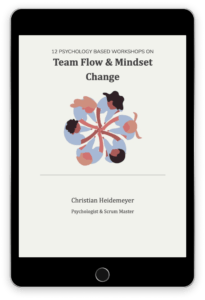It can already be a challenge to facilitate retrospectives in a small team or group. Or with very little time. But what about retrospectives in large teams? These are usually even more demanding.
Before we developed our tool for retrospectives, we had a variety of experiences with larger groups - often we had customers ask that an entire department (usually more than 15 people) should take part in a retrospective.
I would therefore like to share in the first step, what challenges we have experienced in these larger teams or groups.
Challenges in large team or group retrospectives
1. Conversation atmosphere
With large numbers of participants, the participants often know each other only slightly from everyday life. While you can usually rely on a trusting and open discussion atmosphere with small teams, this is often more difficult with large teams. Although it is precisely this trusting atmosphere that is so important for one of the most important factors for successful teams: The psychological safety of the team.
2. Commitment & discussion distribution
At the same time, having a large group retrospective makes it easier for everyone to withdraw from discussions. So, as a moderator, you have to pay more attention to make sure that all participants are dedicated to participating, are able to get involved and that the distribution of discussions is reasonably balanced.
3. Time management
The more team members, the more topics that can be brought to the table. Timeboxing is therefore essential, in order to be able to adequately accommodate all topics.
Reasons to run retrospectives in large teams or groups
Sometimes you have simply no choice, and have to face these challenges. In practice, we typically see the following reasons for running retrospectives in large teams:
- A large team is simply cannot be divided into any other long-term groups. According to the Scrum Guide, 9 team members or more would already consist of a “team too large.”
- A department that consists of several small teams that want to carry out a joint retrospective. In this case, it can be called an “Overall Retrospective” or “Retro of Retros."
The following tips are useful for both scenarios.
Tips for retrospectives in large teams or groups
Here are our tips for retrospectives in large teams!
Tip 1: Question the participants in the retrospective
A large-scale retrospective should definitely be questioned. Is the general setup really unchangeable? Isn't there a sensible alternative?
In the case of large teams or groups, the first question would therefore be whether the team could be divided thematically or not. We are not a fan of strictly interpreting everything according to the textbook (or in this case, the Scrum Guide), but the limitation of up to 9 team members is no coincidence - up to this size, a productive retrospective can take place without restrictions. So if you are significantly above this number, you should question the team constellation.
In "Overall Retros" with several teams, a frequently used "trick" is that each team sends only representatives of the team to the big round. This way, the large round can be kept manageable, at least in terms of the number of participants. The naming of team representatives for "Overall Retros" is also called "Scrum of Scrums" in another framework, namely here: LeSS framework.
Tip 2: Pay attention to confidential handling of conversations
- Even if the team is very large, the content (apart from the measures) is still confidential. → This should be pointed out during the moderation.
- Use a short check-in to create a casual atmosphere – even with little time.
Tip 3: Consider the team size when scheduling
The larger the team, the more topics and the longer the discussions.
So, while in a small team you may be used to completing a retrospective in an hour, this will not be possible with larger groups of participants.
The time required depends heavily on the format and method of the retrospective chosen. In our experience, the periods range between these times:
Usual time frame required for retrospectives depending on the team size
- 5 or fewer participants → 45 - 90 minutes
- 6 to 10 participants → 60 - 120 minutes
- 10 to 20 or more participants → 90 - 180 minutes
Feel free to experiment with timeboxing yourself to get a feel for it. Just take a little more time rather than too little at the beginning, and then see which steps can be optimized - the next tips may be helpful!
Tip 4: Parallelization in the collection of topics and ideas
To parallelize the topic and idea generation, formats or methods such as “1-2-4-All” are options. How does this method work?
Everyone first thinks about a topic or a question individually - for example, 2 minutes (1). Then each participant looks for a partner to exchange these thoughts (2), before joining together in groups of four (4) and finally presenting the collected ideas to the group in a prioritized structure (All).
You can find a more detailed guide to 1-2-4-All on this page: Liberating structures.
Most Agile Coaches and Scrum Masters run in circles...
...fixing superficial symptoms. Time to use psychology to foster sustainable mindset change.
Tip 5: Do health check retros
- Specific statements are presented (see below for examples).
- Each team member evaluates the statements anonymously on a survey scale – how much do you agree from 1 to 7?
- Optional: The results are discussed. Positive and negative examples are collected that might explain the results. This part potentially takes a long time.
- Now prioritize directly by having each team member anonymously vote on which of the statements require the most action (read more: The Best Free Tool for Anonymous Retrospectives: Echometer).
- An action item is only put down for the statement that has the most votes - not the "second most voted" one - to save time.
First, feel free to take a look at our free construction kit, which can provide you with inspiration: 'team health check kit.
Note: This retrospective format asks for agreement with the given Health Check items on a scale.
- Appreciation: My colleagues appreciate my contribution to the team.
- Team Spirit: There is a trusting working atmosphere in our team.
- Transparency: Everyone in my team knows who is currently working on what.
- Recovery & Breaks: I have enough room for breaks in which I can draw new energy.
- Meeting culture: Our meetings are well structured, yet leave room for creativity and new ideas.
- Support: In my team, each team member passes on their individual knowledge and experience.
Do you want your boss to love you? Well, then increase the performance of your team! Go from being an average car to being an explosive rocket.
How? Download my free and science based eBook on "Reaching team flow in 12 easy steps" and take is seriously. But now let's get to the actual topic of this text.
Tip 6: Try Echometer
A super support to perform retros in large groups are good retro tools (see our list: 14 retro tools in comparison). They can do some of the work for you – including collecting feedback before the retro and prioritizing actions.
In particular, I would like to mention a tool that I myself helped to develop: Echometer. It combines insights from psychology with Agile best practices to get the best out of Team Health Checks & Retros for team development.
We provide you with specific (whiteboard) templates in the tool that will help you impress your team. It can be used both online and offline, of course.
By the way, you can use our tool to carry out a retro in a large team without having to register 🙂
With this button you can open the tool directly, choose your retro method and invite a team via link (more than 30 retrospective methods possible):
When you get to the end of the retro, if you want to, you can create a free account to save your results.
Learn more on our tool in general learn more here / start here for free.
Tip 7: Use breakout sessions
Now that topics are brought together and roughly prioritized - despite a large team or group - the topics should be analyzed in detail in order to derive which small action items could be used to improve them.
Here, because the larger the group of participants, it is particularly tricky. A bigger groups more likely means that the topics discussed will not be relevant for everyone. To that effect, only a fraction of the team members can contribute to a topic.
The discussion of certain topics that do not affect all team members equally should therefore be binned or parallelized.
We have had very good experiences with using breakout sessions for this: You set the topics and let self-organizing small groups work on them. Each participant can freely join a group and also leave it again – just like here: open space format.
This way, everyone has the opportunity to be involved in the discussions, where they can actively contribute. In the best case scenario, a tangible measure that can be implemented directly in the next sprint is presented alongside the results of the breakout sessions. If the proposed measures appear plausible and worth pursuing for the entire group of participants, the measures are implemented.
However, it may just be that the small group has not yet been able to come up with a final proposal for a measure. In these cases, a decision can be made to continue the breakout session outside of the retrospective, if the participants consider this to be useful.
Be careful with “half” measures
Nothing is more annoying than a semi-well-thought-out measure that was created under pressure, that nobody wants to take care of. In our experience, it is therefore very important that the moderation in your large team or large group indicates that the decision of another breakout session outside of the retrospective can also be a legitimate measure to continue discussing the topic - Only if it could not be completely analyzed within in the retro time frame.
Tip 8: Collect feedback in advance
Collecting feedback, aka the data gathering phase, can take up valuable time in the retrospective, which you could actually save by asking for feedback in advance.
In order to structure this request for feedback in advance, it is often a good idea to combine closed questions with open questions. In this way, you receive quantitative feedback on targeted aspects and, as a team member, you still have the opportunity to openly contribute your own topics through the open questions. Spotify as a pioneer also uses targeted closed questions, for example, the results of which they have given the following name: squad health check.
In relation to this, we have developed a tool that can support you in your retrospective in large teams. You can find more information directly below.
Retros in small groups are the better solution

Conclusion
You probably gleaned that we would not recommend retrospectives with too large a number of participants for the reasons explained at the outset. The challenge: To moderate the retro.
At the same time, we hope that with the tips on parallelization etc., you can get the best out of big retrospectives. Because especially when you get used to the constellation of the retro as a large team, it can get easier over time, and the format - despite the hurdles - can be a success.
We're eager to hear about your experiences!By the way, if you're still looking for variety in your retros in general, you can also check out this article again: 3 Retro methods with surprise effect.
If you'd like some more varied questions for your retrospectives, check out our post: 54 fresh retrospective methods for beginners and professionals (including the Mario Kart Retro & the Team Morale Health Check).
By the way, if you are still looking for a suitable retro board (with 60+ agile retrospective formats), this post can help you: Comparing the 6 best retrospective boards










